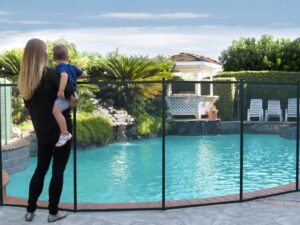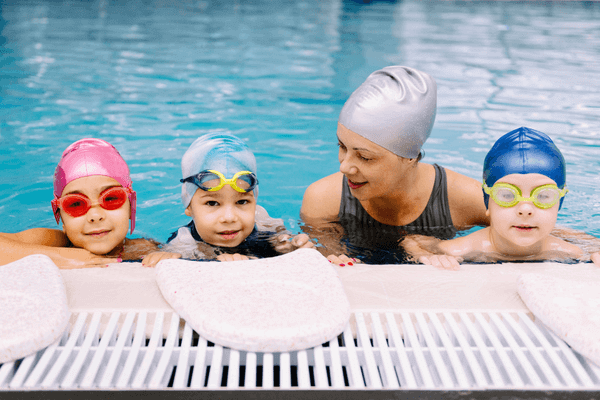
What Makes a Pool Fence Truly “Child-Safe”?
A truly child-safe pool fence does more than meet code. Discover the features parents should prioritize, and how All‑Safe builds fences that families trust.

We’ve mentioned several times that child swim lessons should be a part of creating a safer pool in your home. While our ASTM-compliant safety barriers are perfect for child pool safety, barriers alone aren’t enough. Swimming pool safety takes is not a passive exercise. It takes diligence, perseverance, and making sure everyone is doing their part to create a safer environment around your pool area. While the focus is on the responsibilities of the adults of the house, kids can also play a big part in their own pool safety. That’s where child swim lessons come in.
Swimming lessons aren’t to get your short swimmers ready for the Olympics. They’re meant to give them the basic skills they need to help prevent accidental drowning when they’re at friends’ pool parties, visiting the lake with relatives, or just enjoying your home’s backyard oasis. Swimming classes offer a structured environment where experienced swimmers and swimming professionals can help guide the development of your child’s skills. While you should never make the mistake that children who’ve had swimming lessons can’t down, you can be sure that they’ve worked hard to develop the skills that make it less likely.
You need to choose the right class to deliver the kids’ pool safety instruction that your child needs and that they’re ready to understand and put to use. Children mature at different ages, and so do their skills. A child who develops swimming proficiency early won’t get as much from a lower-level class, while a novice swimmer might not understand the lessons of advanced swimming classes. While we’re going to talk about some broad age ranges to start your child’s swim lessons and set them on a path to pool safety, kids should only be enrolled in classes that are appropriate to their development level. Check with local organizations or the American Red Cross to see what classes are available in your area.
Babies and infants may make reflexive motions in the pool that look like swimming, but that doesn’t mean they’re ready to swim quite yet. Most infants lack the strength or motor control to raise their heads from the water on dry ground or in the pool, making it impossible for them to breathe. Instead, child swim classes for the youngest children focus on increasing comfort and confidence in the pool with touch supervision from a parent, guardian, or another relative. These classes let them experience the fun they can have in the water and help them get used to the new sensations and body movements they’ll eventually use to swim.
Often starting with older infants, water survival courses aren’t based around teaching kids swimming–the intentional movement of themselves through the water–but rather self-preservation. Children are taught how to stay calm, orient themselves in the water, maintain a surface float, and alert nearby adults that they are in distress. Along with classes meant to improve children’s comfort in and around the water, they make the perfect stepping stones toward safer kids’ pool habits.
Not every kid will be ready to learn real swimming skills at a very young age, but if they’ve taken to the water and seem comfortable, you can start them in classes that will teach them the basics. At this age, the instructor-to-student ratio should still either be very high or involve the parents partnered with their children to be a hands-on part of the learning process. They’re likely to learn a few basic swimming strokes as they continue getting more comfortable in the pool.
By the time a child is 4-5 years old, they’re ready to start learning to swim for real. This includes some basic swimming strokes and techniques that let them have plenty of safe fun around the water. Swimming lessons help improve kids’ pool safety and get them ready to play games, get exercise, and splash around with their friends, while you get peace of mind that your child has been trained to handle themselves in the water.
As children age, they’re ready for more advanced swimming techniques. These classes include more complex water movements and a heightened focus on not just their own safety but also on being more aware of the safety of those they share the water with. These classes are meant for bodies that are larger, stronger, and more coordinated than when the children learned basic skills in their child swim classes.
Strong swimmers, scouts, and teens who are interested in military service or becoming a first responder often choose to take their swimming training further. Water safety, rescue, and lifeguard classes teach advanced swimming techniques and skills meant to save lives. From CPR to first aid and pulling at-risk swimmers to safety, these classes prepare your child to face emergency situations calmly with the knowledge and skills they need to make a difference.
No one is drown-proof. Make sure you’re working to prevent unsupervised access to your swimming pool. Even the best swimmers can find themselves in dangerous situations, and children don’t always have the best judgment when it comes to safety limitations. Install pool safety barriers that help prevent accidental drownings on your property.
Our team of local independent installers is ready to help you create a safer pool that meets your responsibilities as a pool owner and gives you the security of knowing your pool is protected. When you request a no-cost, no-obligation quote, they’ll take measurements, talk to you about your expected pool needs, and give you a written estimate on protecting your friends, family, and pets. Get started today. Schedule a visit from your local All-Safe Installer.

A truly child-safe pool fence does more than meet code. Discover the features parents should prioritize, and how All‑Safe builds fences that families trust.

Thinking of installing your own pool fence? Discover the benefits of DIY kits, from cost savings and flexibility to safety compliance, and how All‑Safe makes it possible.

Just got a pool? Learn what every new owner should know, from safety codes and barrier options to basic upkeep and seasonal preparation.
Enter your zip code to locate an independent installer in your area
Enter your zip code to locate an independent installer in your area
Their contact info will be shown on the next screen.
Due to the many variations in monitors, phones, and browsers, color samples and product examples may appear different on different screens. Computers and mobile devices are not all calibrated equally and color reproduction on the Internet is not precise. The same is true for printed items such as brochures and other sales literature.
In addition, the colors of our products photograph differently under different lighting conditions. For example, photos taken in full sunlight will vary from photos taken on a cloudy or overcast day. Similarly, shadows from nearby objects can affect the color and transparency of our products. If a precise color or specific shade is important, please inspect the actual color of your product prior to installation.
Many of our products’ materials are not available through typical stores and vendors and therefore must be custom manufactured specifically for our use. In order to control costs and provide you with the best value possible, our raw materials are produced in large batches and can often take several months to receive. The colors of our materials can, and often do, vary slightly from batch to batch. Although we make every effort to minimize color variations, we cannot be responsible for these differences when they occur. If a precise color or specific shade is important, please inspect the actual color of your product prior to installation.
For example, we use the name “putty” to describe some of our products. Your idea of the color “putty” may be different than someone else’s idea of “putty”. In addition, products may have the same color name but may not be the exact same color. For example, we have different shades of “black”. Please do not order using color names as your only guide. If a precise color or specific shade is important, please inspect the actual color of your product prior to installation.
If it is important that your product be an exact color or shade, it is highly recommended that you inspect the actual product prior to its installation and address any concerns with your local independent installer. Most independent installers do not offer refunds or accept returns due to color variations.